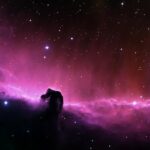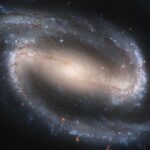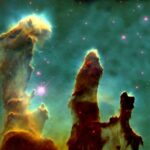An emission nebula is a nebula formed of ionized gases that emit light of various colors. The most common source of ionization is high energy photons emitted from a nearby hot star. Among the several different types of emission nebulae are H II regions, in which star formation is taking place and young, massive stars are the source of the ionizing photons; and planetary nebulae, in which a dying star has thrown off its outer layers, with the exposed hot core then ionizing them.
Usually, a young star will ionize part of the same cloud from which it was born although only massive, hot stars can release sufficient energy to ionize a significant part of a cloud. In many emission nebulae, an entire cluster of young stars is doing the work.The nebula’s color depends on its chemical composition and degree of ionization. Due to the prevalence of hydrogen in interstellar gas, and its relatively low energy of ionization, many emission nebulae appear red due to the strong emissions of the Balmer series.






